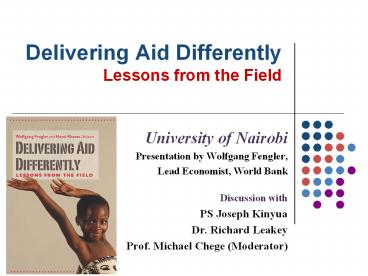University of Nairobi - PowerPoint PPT Presentation
1 / 28
Title:
University of Nairobi
Description:
Delivering Aid Differently Lessons from the Field University of Nairobi Presentation by Wolfgang Fengler, Lead Economist, World Bank Discussion with – PowerPoint PPT presentation
Number of Views:107
Avg rating:3.0/5.0
Title: University of Nairobi
1
Delivering Aid DifferentlyLessons from the Field
- University of Nairobi
- Presentation by Wolfgang Fengler,
- Lead Economist, World Bank
- Discussion with
- PS Joseph Kinyua
- Dr. Richard Leakey
- Prof. Michael Chege (Moderator)
2
About Homi Kharas
- PhD in Economics from Harvard and BA from Kings
College, Cambridge - Served as Chief Economist, World Bank, from
1999-2007 in the East Asia and Pacific Region - Currently a Senior Fellow and Deputy Director for
the Global Economy and Development Program, at
the Brookings Institute in Washington DC where he
leads research on aid effectiveness.
3
About Myself
- Born in Germany, January 1971
- Graduated from German Universities in 1996
(Masters) and 2000 (PhD) - Founded a number of companies including Africa
Consulting in the 1990ies - Left Germany and joined World Bank in January
2000 - Became World Bank Senior Economist in Indonesia,
2004 - Moved to Kenya as Lead Economist, World Bank,
August 2009
4
About the Book
- Describes the new realities of a US 200 billion
aid industry that has overtaken the traditional
aid model. - 10 chapters
- Overview
- 6 Country Case Studies Kenya, Ethiopia, Aceh
(Indonesia), Cambodia, Pakistan, Tajikistan - 3 Thematic Chapters Joint Assistance Strategies,
Information Systems, Humanitarian Aid - All country case studies written by scholars of
aid-recipient countries, including Francis Mwega
(University of Nairobi)
5
Main Messages
- Aid Can Work. From the Marshall Plan in Europe
after World War II to M-PESA in Kenya today, aid
has often played a critical role in the
development of countries. - The New Reality of Aid. The number of new players
has increased rapidly and the demands of clients
has differentiated. New players have brought
fresh energy and approaches to the delivery of
aid. But they have also added to fragmentation
and volatility. - Delivering Aid Differently. Filling gaps is not
sufficient. Today, aid needs to leverage
knowledge, the hardest currency of the 21st
century, to evaluate programs, identify success,
and then scale up.
6
- Aid Can Work
7
The Marshal Plan Europe
- The US Govt spent US 13 billion to help rebuild
Europe after World War II
8
The Green RevolutionWorld Wide, mainly Asia,
Latin America
- With the help of aid-funded research,
agriculture yields increased and made India self
sufficient in food grains.
9
Bolsa FamiliaBrazil
- The worlds largest conditional Cash Transfer
program has scaled-up to cover more than 12
million Brazilian families with the help of the
World Bank, IDB and other partners
10
Post-Tsunami ReconstructionIndian Ocean
- In Aceh, the US 7.2 billion reconstruction
program led to recovery of the province (2/3
financed by the international community)
11
Mobile MoneyKenya
- More than 13 million Kenyans (62 of all adults)
are now transferring an estimated 15 of GDP
through their phones. This innovation was
initiated through a DFID grant.
12
The New Reality of Aid
13
The Old Reality of Aid
14
The New Reality of Aid
15
Seeing the new Aid Architecture in 3D
Demand Differentiation
Diversity of Donors
Dynamics of Development
Traditional donors, New Bilaterals, NGOs
A wide spectrum of clients Fragile states, MICs,
small states, etc.
Innovation, Information, Evaluation, Scaling up
16
Since 1992, aid has doubled, mainly due to the
emergence of new players
- Total Development Assistance from OECD, 1992
- Total Development Assistance from OECD, 2008
17
The total number of projects has quadrupled while
the average size declined sharply (ODA only)
18
and New Players have added to Increased
FragmentationCase study Aceh (Indonesia)
Note 1 maximum concentration. The lower the
index the more fragmented the aid program
19
... while Chinas share is rising rapidly Case
study Cambodia
20
Aid to Kenya has been declining until recently
... Case study Kenya 1981-2006
21
... and donor funding has become increasingly
unpredictable Case study Kenya 1981-2006
22
Delivering Aid Differently
23
Country Level Coordination and a knowledge
engine
Donors and Implementers
Projects and Programs
National Aid Coordination Agency
Information
Needs
Standards
Data on Inputs
Data on Outputs
24
Delivering Aid Differently Effective
Coordination and alignment with government
Post-Tsunami Reconstruction, Aceh
Government
Donors
Coordination Forum
Multi Donor Fund
Reconstruction Agency
UNORC
?
UN Agencies
NGOs
Communication Coordination fora
25
Delivering Aid Differently Analysis driving
programming Post-Tsunami Reconstruction, Aceh
26
Delivering Aid Differently Scaling-Up From
small projects to large programs The Indonesia
Community Empowerment Program
Government took over, doubled the scope and
finances most investments WB continues to
support ME and supervision of program
Introduction of the project
Pilot 25 villages
27
Delivering Aid Differently Summary
Old aid model New aid model
Overall approach International coordination and burden sharing, collaboration between headquarters dominates In-country coordination and recipient government-led, differentiated by situational demands
Sources and channels Official Development Aid focus Diverse multi-player, multi-channel aid
Programming Annual Multi-year, dynamic
Delivery Project-based, fragmented Programmatic, scalable
Capacity building Capacity substitution, technical assistance Capacity development, local networks
Information systems Global Global and local
28
Asante SanaThank You
- www.brookings.edu
- http//www.worldbank.org/ke
- For more information on this book, please contact
Wolfgang Fengler (wfengler_at_worldbank.org) or - Homi Kharas (hkharas_at_brookings.edu)
- To order the book
- Hopkins Fulfillment Service, P.O. Box 50370,
- Baltimore, MD 21211-4370 Phone 1-800-537-5487
or 410-516-6956Fax 410-516-6998, E-mail
hfscustserv_at_press.jhu.edu - or through
- www.Amazon.com































